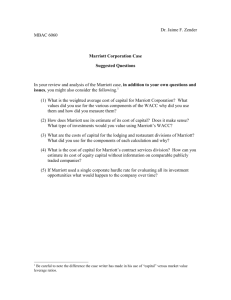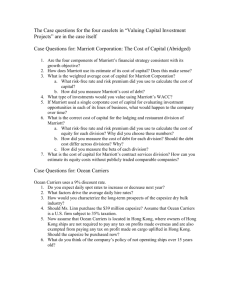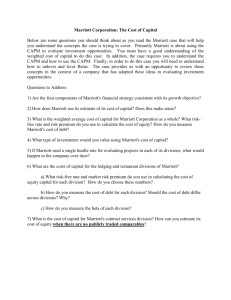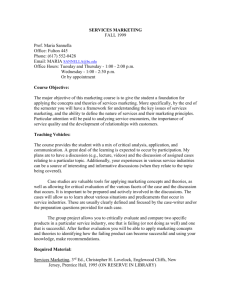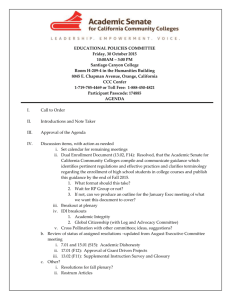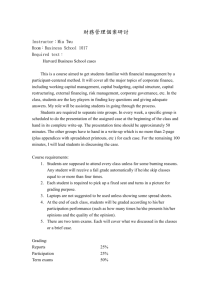8 Corporate Social Responsibility and the Sustainable Tourism
advertisement
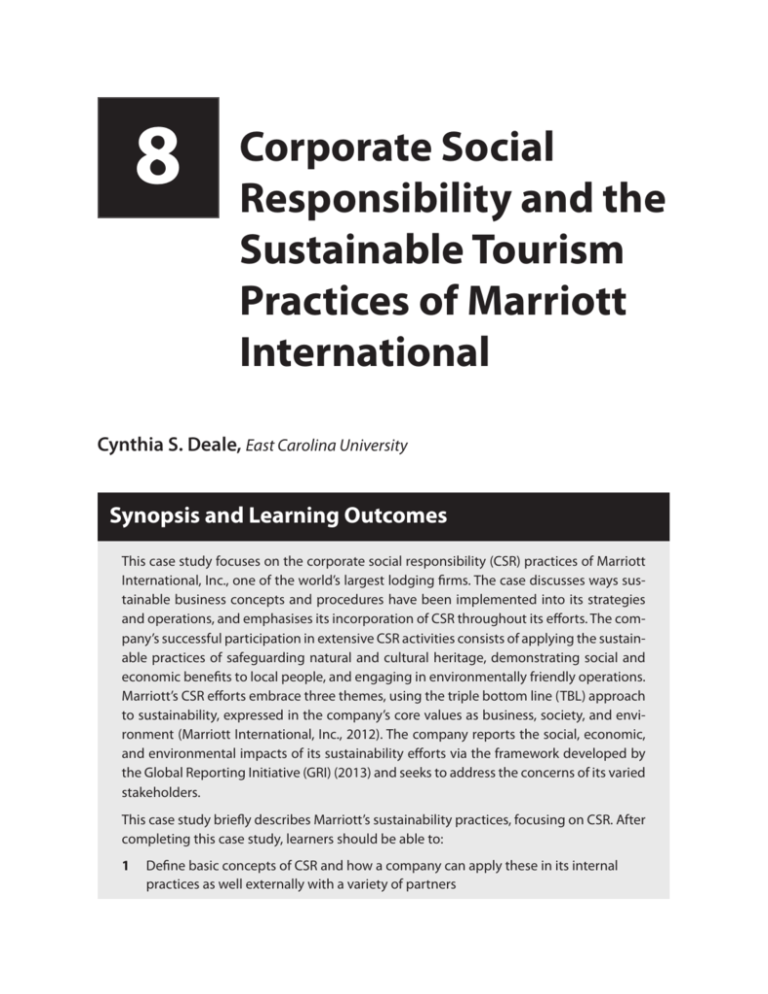
8 Corporate Social Responsibility and the Sustainable Tourism Practices of Marriott International Cynthia S. Deale, East Carolina University Synopsis and Learning Outcomes This case study focuses on the corporate social responsibility (CSR) practices of Marriott International, Inc., one of the world’s largest lodging firms. The case discusses ways sustainable business concepts and procedures have been implemented into its strategies and operations, and emphasises its incorporation of CSR throughout its efforts. The company’s successful participation in extensive CSR activities consists of applying the sustainable practices of safeguarding natural and cultural heritage, demonstrating social and economic benefits to local people, and engaging in environmentally friendly operations. Marriott’s CSR efforts embrace three themes, using the triple bottom line (TBL) approach to sustainability, expressed in the company’s core values as business, society, and environment (Marriott International, Inc., 2012). The company reports the social, economic, and environmental impacts of its sustainability efforts via the framework developed by the Global Reporting Initiative (GRI) (2013) and seeks to address the concerns of its varied stakeholders. This case study briefly describes Marriott’s sustainability practices, focusing on CSR. After completing this case study, learners should be able to: 1 Define basic concepts of CSR and how a company can apply these in its internal practices as well externally with a variety of partners 104 International Cases in Sustainable Travel & Tourism 2 Describe the TBL approach to sustainability in lodging operations in terms of the interconnections between the economy, the natural environment, and the social and cultural realm, and specifically CSR. 3 Explain best practices for CSR that can be implemented in lodging operations. 4 Identify opportunities and challenges and the give and take involved in balancing the TBL approach to practicing sustainability in lodging operations, particularly while embracing CSR throughout an operation. 5 Suggest additional sustainability practices that would be useful and desirable in the future in lodging operations. Background The Company Marriott International, Inc. began in 1927 in the United States (U.S.), when J. Willard Marriott and his wife opened a small root beer stand, later called the Hot Shoppe, in Washington, DC. In 1939, the Marriotts acquired their first foodservice management contract with the U.S. Treasury, growing their business and Hot Shoppes, Inc. In 1957, they opened their first hotel in Virginia (Marriott International, Inc., 2012a). The corporate name of Hot Shoppes, Inc. was changed to the Marriott Corporation in 1967 and the business expanded into airline food service, food production, and lodging. In 1969, Marriott opened a hotel in Mexico, its first property outside of the U.S. In 1972, J.W. Marriott, Jr. was named Chief Executive Officer (CEO) and in 1975, the company opened its first European hotel, in Amsterdam. Marriott opened its 100th hotel in Hawaii in 1981, began the Courtyard concept in 1983, and entered the vacation time-share and senior-living segments of the industry in 1984 (Marriott, 1997). Marriott International, Inc. continues to expand and flourish, with over 3,700 lodging properties in 74 countries (Marriott News Center, 2013). As of 2013, the company operates and franchises hotels under 18 brands; these include Marriott Hotels & Resorts, The Ritz-Carlton, JW Marriott, Bulgari, EDITION, Renaissance, Gaylord Hotels, Autograph Collection, AC Hotels by Marriott, Courtyard, Fairfield Inn & Suites, SpringHill Suites, Residence Inn, TownePlace Suites, Marriott Executive Apartments, Marriott Vacation Club, Grand Residences by Marriott, and The Ritz-Carlton Destination Club (Marriott News Center, 2013). To staff these properties, it employs more than 300,000 people around the world, at its headquarters or in managed and franchised properties. The company reported sales from continuing operations of $12 billion for the fiscal year 2011 (Marriott News Center, 2013). CSR and the Sustainable Tourism Practices of Marriott International 105 Marriott’s Sustainability Efforts The company’s sustainability practices are widespread and substantial. In 2007, the company developed the Marriott Environmental Public Policy Statement and in its sustainability reports for the years of 2009 through 2012, Marriott cited accomplishments in the areas of immigration and integration, global diversity and inclusion, ethics and human rights, poverty alleviation, disaster relief efforts, vitality of children, the environment (energy, water, waste, carbon), green buildings, the supply chain, educating and inspiring associates and guests, and the ‘Spirit to Preserve’ - Juma Reserve and Nobility of Nature projects (Marriott International, Inc., 2009; 2010; 2012). In 2009 alone, the company celebrated its 10-year anniversary of the Women’s Leadership Development Initiative, commemorated the 20-year anniversary of its formal programs to promote diversity and inclusion, expanded its portfolio of LEED-certified buildings to include more than 85 hotels and its global headquarters (Matthews, 2011), and was awarded the World Travel and Tourism Council (WTTC) ‘Tourism for Tomorrow Award for Sustainability’ (Marriott International, Inc., 2009). It has continued to receive recognition for its sustainability efforts, including being chosen as one of the world’s best companies for working women in 2012 (Working Mother, 2012), being ranked the top large hotel chain in terms of its sustainable business practices for three consecutive years (Climate Counts, 2012), and earning the 2013 Work-Life Seal of Distinction from the World at Work’s Alliance for Work-Life Progress (AWLP) (Marriott News Center, 2013b). In addition, it has been repeatedly recognised as one of the best companies to work for by FORTUNE magazine and as one of the most environmentally friendly large companies in the U.S. by Newsweek magazine (Marriott News Center, 2013a). Key Concepts Several concepts underlie the sustainability efforts practiced by Marriott. These include fundamental components of sustainable development and CSR efforts, which are threaded throughout Marriott’s sustainability initiatives and practices. In addition, Marriott’s environmental vision and goals provide a context for the case. Background elements of sustainability that may be helpful for understanding this case, include: Definitions of sustainable development and sustainability (World Commission on Environment and Development,1987). Foundations of the TBL (triple bottom line) of sustainability (Elkington, 1997; Hawken, 2007: Hawken, 1993; Hawken et al., 1999). A focus on employees and the community as keys to fostering and supporting the sustainability process (Senge, 2008). 8

